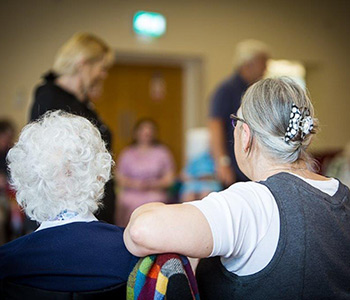I find myself in a reflective mood this morning. I guess this happens after life changing personal events.
Anyway, it was after watching “Call the Midwife” and the episodes set in the asylum that I started to remember. The series is set in the 1960’s and it struck me that when I was visiting Fairfield Hospital at Arlesey from 1989 to 1995 when it closed – how little things had changed. It was scary on TV and it was scary in real life. I used to visit every week because as the specialist social worker for dementia it was part of my job to be the liaison between North Beds. Social Services and the psychiatric hospital.
All people over 65 were accommodated in the hutted area – built during the World War 2 I believe. There was one ward for men and one for women. People were all mixed up together – although most of the patients were diagnosed with dementia, they shared the wards with those with functional mental illness such as schizophrenia and bi-polar disorder. They were meant to be assessment wards but many people spent years in those wards. It was not that the staff were deliberately unkind. It was the system that was wrong. The doors were always locked, people had no personal living space but spent their days in Nightingale wards – sleeping area at one end – Day Room at the other. They had a bed and a locker. I’m not sure if they even had bed curtains.
They were locked away in the asylums – out of sight and out of mind. They were centres of what was commonly known as “challenging behaviour” which was treated with the liberal use of anti-psychotic drugs. The staff all believed that this was a natural part of the condition. “It’s the dementia!” they would say, if asked. No attempt was made to understand the reasons for this behaviour.
Now in the days of 24/7 news coverage we often see & hear stories about poor living conditions and treatment of people with dementia and it’s easy to think that in thirty years we have made little progress. But we have. Fairfield and all the other ‘asylums’ have closed. People with dementia spend much longer at home in the community than they used to. If they do move into a care home it will be for a period of a couple of years at most. We do understand that “behaviours of protest and disruption” are not an inevitable part of dementia but are a response to a trigger. All too often the trigger is the way that they are being treated by other people.
The frustrating thing now is that we have the knowledge to help people to live well with dementia. Some people know because they have been trained in the new culture. I hope and pray that we do in the Tibbs Dementia community. But EVERYONE working in the field needs training. It should be a legal requirement. It is not rocket science but good dementia care is counter intuitive – it’s the opposite of common sense. We need to be taught how to do it. Using logic and reasoning and thinking that if we just explain often enough the person with dementia will understand does not work.
But the asylum casts a long shadow. The old culture of dementia care is tragically still alive and well in many places. If the scenes in “Call the Midwife” are an accurate picture of the way things were in the mid 1960’s and things had not substantially changed by the 1990’s – it shows how long it can take for institutionalised bad practice to change. I hope we won’t have to wait another thirty years.




